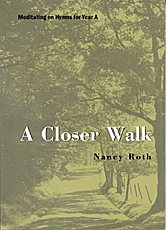About the Series:
Christian hymns that have been sung over and over down through the years find a home in our hearts. In the oddest moments we begin humming their tunes and remembering their words. In moments of happiness, we use them to express joy and praise. In time of pain and sorrow, they bring us solace. These songs link us to congregations from centuries ago, to the communities we have sung with at other times in our lives, and to Christians around the world today who are singing the same hymns in different languages.
Nancy Roth, an Episcopal priest, educator, and spiritual director has written a series of three books on using hymns for meditation. These handy resources are designed to be used in conjunction with Poems of Grace, the text-only version of The Hymnal 1982. "When we take the time to look through the 'window' a hymn provides, it does not remain a one-way glass," Roth writes. "Gradually, if we take the time, the hymn begins to speak to us as well. It addresses us from across time and space. It begins to speak to our spirits. Through the hymn, we begin to hear the voice of God, and the hymn, in turn, becomes our prayer."
Roth presents a brief historical look at the hymn and its author along with a meditation that can be used as a spur to personal devotion or as a study program in Christian education. She suggests a meditative pattern for processing the hymns by preparing, picturing, pondering, gathering, and singing. The hymns chosen follow the church year, beginning with Advent and including all Sundays and major Holy Days.
About this volume:
This volume about the hymns for Year A includes considerations of hymns by Dietrich Bonhoeffer, Phillips Brooks, William Cowper, Harry Emerson Fosdick, Martin Luther, Thomas Aquinas, Issac Watts, Charles Wesley, Richard Wilbur, and many others. Roth describes "There Is a Wideness in God's Mercy" as "one of the most comforting of all hymns." She notes that "Joy to the World" encourages us to get in touch with the transformation resulting from Christ's birth by listening to "heaven and nature singing." The Shaker song " 'Tis the Gift To Be Simple" reminds Roth of the importance of body-language as a part of worship. The author, who also teaches Christian yoga, uses the lines of the hymn as the basis of a devotional exercise:
"The Shakers believed that the 'scooping' movements gathered blessings, and that the shaking movements got rid of evil. How appropriate that these movements are set to the words that describe the simple freedom of knowing 'where we ought to be.' When you scoop your arms, mentally picture gathering the blessing of knowing yourself loved by God. When you shake your arms, picture yourself shaking off those things that get in the way of the blessing of God's love. To know the 'simple' truth enacted through this scooping and shaking is freedom. When we learn to move through life in the context of that freedom, we know we are in 'the place just right.' "
